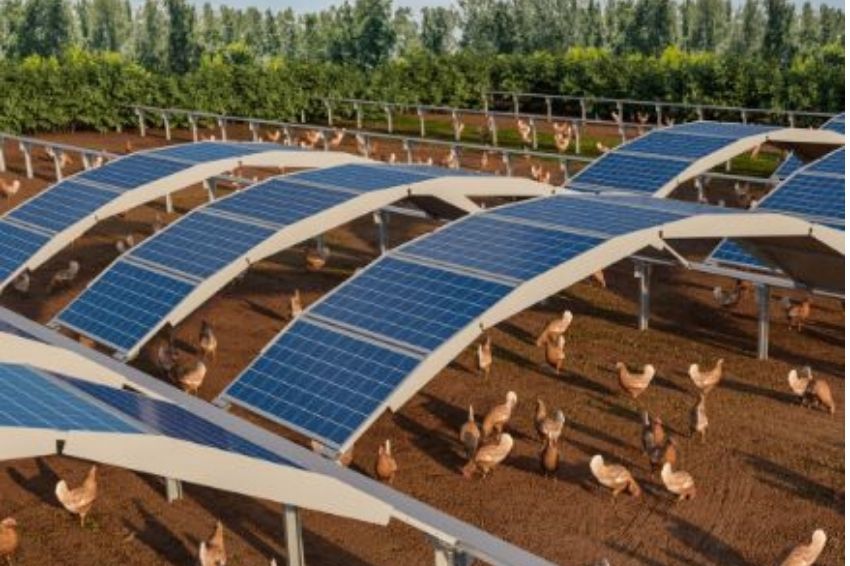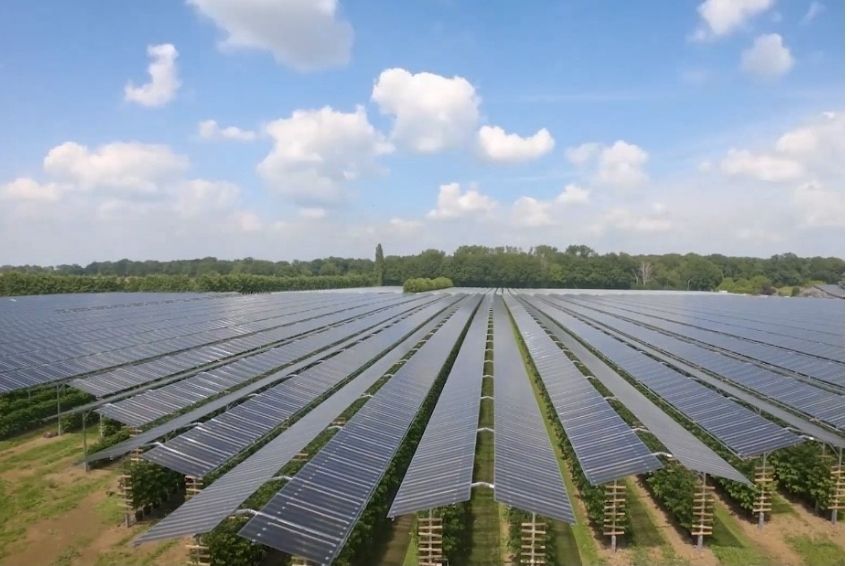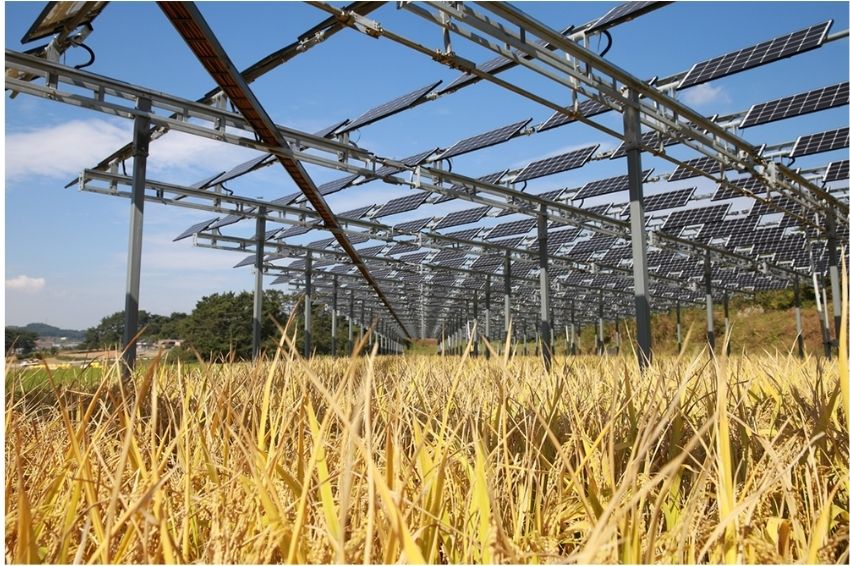According to Isaac Newton, two bodies cannot occupy the same place in the same space. Therefore, can agriculture and photovoltaic energy generation coexist in the same space?
This question is being answered through agrivoltaic systems, an application that enables the coexistence of agricultural production and solar energy generation on the same piece of land.
Not all crops are suitable for this application, so this type of project needs to be coordinated with agronomists and integrators' engineering teams. The combination began to be considered a viable option a few years ago and is currently seen by European and Asian countries as an alternative to conventional solar parks.
At China, more than 1 GW of installed power comes from the use of the system, which when introduced in the field, helps to use land and water resources more efficiently and also guarantees extra income for the rural owner. The application basically consists of solar panels installed at a height that allows machines to pass underneath the panels.
The equipment also brings the benefits of reducing water demand by around 20%, increasing productivity and reducing crop losses – a direct consequence of constant exposure to the sun. As it is a relatively new technology, the models continue to be improved.
In Brazil, there are still no projects of this nature, but a group formed by four companies – ARaymond, SNEF Brasil, MMA Advogados and the Port Trade Group – entered into a partnership to bring the system to the country.
Logistics for Brazil
According to the companies involved in the project, there is still no defined date or regions for the arrival of solar technology in the country. The initial idea, however, is to start implementing the system in the agribusiness. At the moment, the group is holding weekly meetings with several cooperatives to show how the application works and its benefits for the agricultural sector.
MMA Advogados is responsible for organizing all issues involving the legal side, including the regulatory area, tax and contractual planning, while engineering, import and installation will be handled by SNEF Brasil
On the other hand, issues involving negotiation, purchase and transportation of equipment will be the responsibility of the Port Trade Group and ARaymond is responsible for ensuring the fixation of the structures.
Check out examples of agrivoltaic systems around the world below
Germany
This year, German EPC contractor Goldbeck Solar developed an arc-shaped agrivoltaic system for applications in agrivoltaic projects. Called MarcS, the system was created in partnership with PMT, a supplier of assembly structures.
Basically, the arches are designed to slide into the side rails so that the positions of the solar modules can be flexibly adjusted and the arable land underneath can be exposed or protected from the sun, depending on the farmer's needs. At the same time, solar modules offer protection to animals and plants against extreme weather conditions such as hail, drought and excessive sunlight.
Temperature, humidity and light can also be controlled and breeding and harvest quality can be optimized. The assembly is made up of rows of arched solar modules at a height of 2.5m to 3.5m. The arrangement connects the modules with the substructure to form a static fixed part, which can span up to 9m, according to Goldbeck Solar.
Netherlands
In the Kingdom of the Netherlands, Europe's largest agricultural photovoltaic plant was completed in June 2020. The Babberich project, implemented by BayWa re, has a capacity of 2.67 MWp and covers 3.3 hectares of a farm where raspberries are grown .
Thanks to the semi-transparent sunroof, no plastic hoops are needed to protect the fruit from extreme weather events. The solution also provides a stable climate for fruit growing and, at the same time, generates clean, renewable energy.
Australia
In Australia, Wynergy proposes a model based on 5 MW plants with panels mounted on elevated structures and single-axis tracking systems, to be implemented in New South Wales. According to the company, the energy generated on site can be supplied to the grid and sold to electricity distribution companies, while farmers will be able to count on a guaranteed fixed income.
South Korea
QCells is another company that has also been operating in the manufacture of agrivoltaic systems. Recently, the company developed a compact photovoltaic module, half the traditional size, to ensure that agricultural solar installations generate electricity, maintaining an adequate amount of sunlight for crops.
The company was also selected as a joint research partner by the Government of South Korea for the “Agrivoltaic System Standardization Project” to conduct a study aimed at establishing localized systems for rice fields, agricultural fields and orchards.
The company has already created a site to test the systems in Namhae, South Korea, with the aim of verifying the potential usefulness of the technology in Korean lands.
China
In the Asian country, the Baofeng Group is expanding its capacity from 640 MW to 1 GW through a solar park, installed in Ningxia province, close to the Yellow River. The tributary is known for being an important economic valley, with fertile land, good pastures and a large amount of mineral deposits.
In this project, the company is combining solar energy with the production of goji berries, an ingredient in traditional Chinese, Korean and Japanese medicine. The panels were installed at a height of 2.9m, aiming to provide sufficient space for growing the condiment and ensuring the proper functioning of the agricultural land.























5 Responses
The news is good, but in Brazil, there is no future, in these countries this type of investment has support and value. In our country, we already approve charging fees, only to end up taking advantage of it for the rich and politicians. But the idea is very good.
Fantastic. The condition of obtaining greater and
More Production Quality at Cost
Lots of bass.
I work with Photovoltaic Systems and would like
To participate in the evolutionary process
At.Claudio
In addition to these technologies on land, there is also floating solar generation, which takes advantage of the surfaces of lakes and ponds to generate energy, maximizing the use of land for agriculture or livestock. In addition, evaporation under floating plants is reduced by up to 70% contributing to the preservation and longevity of the water resource.
AND!!!???
I HOPE THE FUTURE IS NOW!!!
DUE TO SO MANY INDICATORS
SO POSITIVE.
WE NEED TO PUT THIS SUSTAINABLE POSSIBILITY INTO PRACTICE AND IF
SHOWING VIABILITY WE JUST NEED
REDUCE COSTS AND THEN WE WILL BE IN
21ST CENTURY…
What good news! Following the installation of plants with the plates at a low height, I always asked myself why it was necessary to prevent the use of soil under the plates, especially the translucent ones. New perspectives open up with technological advances.